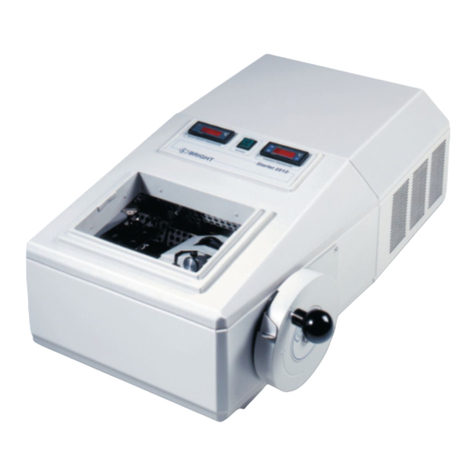
Bright Instruments 9
2. Operating Instructions
On receipt of your new Bright instrument,
please refer to section 1.1 (Receipt and
Unpacking) and section 1.2 (Assembly and
Installation).
As part of its policy of continual improvement,
Bright Instrument Company Limited, reserves
the right to incorporate changes, or make
additions to, without prior notice. There
may, therefore, be minor details differences
between the information in this manual and
your instrument. These differences will not
affect the safety and use of the instrument.
Refer to Fig. 1.
2.1 OPERATING HANDLE [FIG. 1.3]
Semi automatic advance – when pushed
towards the knife the sledge will move
along the runners and will also advance the
specimen the selected amount (thickness).
When pulled back the specimen retraction
mechanism is activated.
2.2 THICKNESS CONTROL [FIG. 1.5]
A knob, calibrated in microns, is used to
select the thickness of sections to be cut from
1µm – 40µm, in 1µm steps. Always set the
thickness by turning the knob anticlockwise.
If the thickness has to be reduced then turn
clockwise past the required thickness, then
anticlockwise.
2.3 COARSE ADVANCE/TRIM CONTROL
Quickly raises or lowers the specimen 450µm
per turn. As this control is always engaged, it
can be used at any time.
2.4 SPECIMEN HOLDER
Specimens are clamped in the vice [7] or
alternative holder if fitted. The specimen
holder can be raised and lowered after
releasing the clamp lever [21].
2.5 KNIFE CLAMPS
Two screws, turned by a lever [10], are used to
fix the knife in the knife clamp and the knife
clamp in the knife block [9]. The cutting angle
of the knife is adjustable from 0-40º. A scale
is provided on the knife block. Slew angles of
the knife can be obtained by loosening the
knife block clamp levers [12] and the knife
clamp levers [10] and moving knife to slew
angle required.
2.6 KNIFE GUARDS
Each knife guard [1] can be moved to the
central position to cover the working area
of the knife, or to the outer position while
section cutting. The black knobs secure the
guards in the chosen position.
2.7 SIDE PILLARS (FIG. 1.13 & 1.16)
In normal use, these pillars slope inwards
slightly. For large area sections they can be
unbolted from the base, swapped left to right
and refitted, so that they slop outwards, so
providing more space.




























